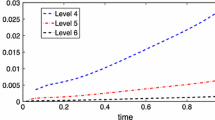Abstract
We prove unconditional long-time stability for a particular velocity–vorticity discretization of the 2D Navier–Stokes equations. The scheme begins with a formulation that uses the Lamb vector to couple the usual velocity–pressure system to the vorticity dynamics equation, and then discretizes with the finite element method in space and implicit–explicit BDF2 in time, with the vorticity equation decoupling at each time step. We prove the method’s vorticity and velocity are both long-time stable in the \(L^2\) and \(H^1\) norms, without any timestep restriction. Moreover, our analysis avoids the use of Gronwall-type estimates, which leads us to stability bounds with only polynomial (instead of exponential) dependence on the Reynolds number. Numerical experiments are given that demonstrate the effectiveness of the method.





Similar content being viewed by others
References
Badia, S., Codina, R., Gutiérrez-Santacreu, J.V.: Long-term stability estimates and existence of a global attractor in a finite element approximation of the Navier–Stokes equations with numerical subgrid scale modeling. SIAM J. Numer. Anal. 48(3), 1013–1037 (2010)
Bensow, R., Larson, M.: Residual based VMS subgrid modeling for vortex flows. Comput. Methods Appl. Mech. Eng. 199, 802–809 (2010)
Brenner, S., Scott, L.R.: The Mathematical Theory of Finite Element Methods. Springer, New York (2008)
Chen, W., Gunzburger, M., Sun, D., Wang, X.: Efficient and long-time accurate second-order methods for Stokes–Darcy system. SIAM J. Numer. Anal. 51(5), 2563–2584 (2013)
Foias, C., Temam, R.: Gevrey class regularity for the solutions of the Navier-Stokes equations. J. Funct. Anal. 87(2), 359–369 (1989)
Gallay, T., Wayne, C.E.: Invariant manifolds and the long-time asymptotics of the Navier–Stokes and vorticity equations on \(R^2\). Arch. Ration. Mech. Anal. 163(3), 209–258 (2002)
Gatski, T.B.: Review of incompressible fluid flow computations using the vorticity–velocity formulation. Appl. Numer. Math. 7(3), 227–239 (1991)
Gottlieb, S., Tone, F., Wang, C., Wang, X., Wirosoetisno, D.: Long time stability of a classical efficient scheme for two-dimensional Navier–Stokes equations. SIAM J. Numer. Anal. 50(1), 126–150 (2012)
Guillen-Gonzalez, F., Gutierrez-Santacreu, J.V.: Unconditional stability and convergence of fully discrete schemes for 2D viscous fluids models with mass diffusion. Math. Comput. 77(263), 1495–1524 (2008)
Gunzburger, M.: Finite Element Methods for Viscous Incompressible Flows: A Guide to Theory, Practice, and Algorithms. Academic Press, Boston (1989)
Hairer, E., Wanner, G.: Solving Ordinary Differential Equations II: Stiff and Differential-Algebraic Problems, 2nd edn. Springer, Berlin (2002)
Heywood, J., Rannacher, R.: Finite element approximation of the nonstationary Navier–Stokes problem. Part I. Regularity of solutions and second-order error estimates for spatial discretization. SIAM J. Numer. Anal. 19(2), 275–311 (1982)
Heywood, J., Rannacher, R.: Finite element approximation of the nonstationary Navier–Stokes problem. Part II: stability of solutions and error estimates uniform in time. SIAM J. Numer. Anal. 23(4), 750–777 (1986)
Heywood, J., Rannacher, R.: Finite-element approximation of the nonstationary Navier–Stokes problem. Part IV: error analysis for second-order time discretization. SIAM J. Numer. Anal. 27(2), 353–384 (1990)
John, V.: Reference values for drag and lift of a two dimensional time-dependent flow around a cylinder. Int. J. Numer. Methods Fluids 44, 777–788 (2004)
Johnson, C., Rannacher, R., Boman, M.: Numerics and hydrodynamic stability: toward error control in computational fluid dynamics. SIAM J. Numer. Anal. 32(4), 1058–1079 (1995)
Lee, H.K., Olshanskii, M.A., Rebholz, L.G.: On error analysis for the 3D Navier–Stokes equations in velocity–vorticity–helicity form. SIAM J. Numer. Anal. 49(2), 711–732 (2011)
Majda, A., Bertozzi, A.: Vorticity and Incompressible Flow, vol. 27. Cambridge University Press, Cambridge (2002)
Najjar, F., Vanka, S.: Simulations of the unsteady separated flow past a normal flat plate. Int. J. Numer. Methods Fluids 21(7), 525–547 (1995)
Olshanskii, M.A., Heister, T., Rebholz, L., Galvin, K.: Natural vorticity boundary conditions on solid walls. Comput. Methods Appl. Mech. Eng. 297, 18–37 (2015)
Olshanskii, M.A., Rebholz, L.: Velocity–vorticity–helicity formulation and a solver for the Navier–Stokes equations. J. Comput. Phys. 229, 4291–4303 (2010)
Saha, A.: Far-wake characteristics of two-dimensional flow past a normal flat plate. Phys. Fluids 19(128110), 1–4 (2007)
Saha, A.: Direct numerical simulation of two-dimensional flow past a normal flat plate. J. Eng. Mech. 139(12), 1894–1901 (2013)
Simo, J., Armero, F.: Unconditional stability and long-term behavior of transient algorithms for the incompressible Navier–Stokes and euler equations. Comput. Methods Appl. Mech. Eng. 111(1), 111–154 (1994)
Tone, F.: On the long-time stability of the Crank–Nicolson scheme for the 2D Navier–Stokes equations. Numer. Methods Partial Differ. Equ. 23(5), 1235–1248 (2007)
Tone, F., Wirosoetisno, D.: On the long-time stability of the implicit Euler scheme for the two-dimensional Navier–Stokes equations. SIAM J. Numer. Anal. 44(1), 29–40 (2006)
Wang, X.: An efficient second order in time scheme for approximating long time statistical properties of the two dimensional Navier–Stokes equations. Numer. Math. 121(4), 753–779 (2012)
Author information
Authors and Affiliations
Corresponding author
Additional information
T. Heister was partially supported by the Computational Infrastructure in Geodynamics initiative (CIG), through the National Science Foundation under Award No. EAR-0949446 and The University of California—Davis and NSF Grant DMS1522191. M. A. Olshanskii was partially supported by Army Research Office Grant 65294-MA and NSF Grant DMS1522192. L. G. Rebholzz was partially supported by Army Research Office Grant 65294-MA and NSF Grant DMS1522191.
Rights and permissions
About this article
Cite this article
Heister, T., Olshanskii, M.A. & Rebholz, L.G. Unconditional long-time stability of a velocity–vorticity method for the 2D Navier–Stokes equations. Numer. Math. 135, 143–167 (2017). https://doi.org/10.1007/s00211-016-0794-1
Received:
Revised:
Published:
Issue Date:
DOI: https://doi.org/10.1007/s00211-016-0794-1



